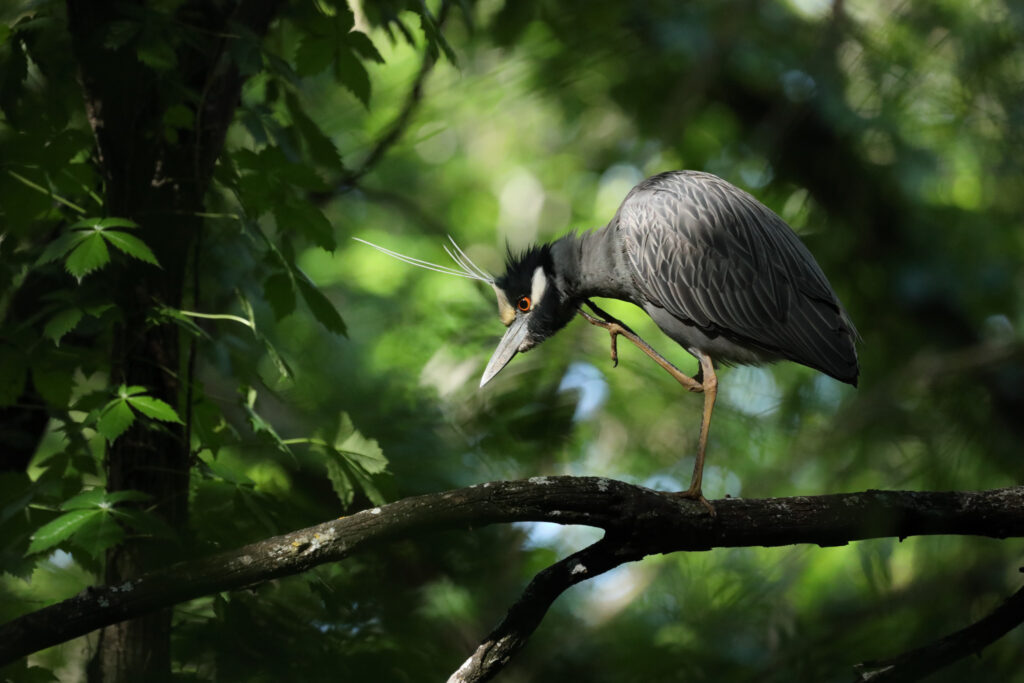John W. Garbutt, Class of 2019
March was winding down. The morning was cool, which made for a lovely morning to make another attempt at locating the Cooper’s Hawks’ nest in the riparian area of the park. I finally found it on the 26th. It turned out that the Hawks were renovating the previous year’s construction. Excited with the discovery, I decided to head down the path to scout where the Yellow-crowned Night-Heron pair nested the previous year near the creek.
To my surprise, I found five Night-Herons already engaged in courtship displays and nesting activities. Large birds like a hawk or heron will reuse a nest because of the effort involved in nest construction. For the pair renovating the 2022 nest, I decided to call that Site A. The second pair was interested in a spot across the creek. They became the pair at Site B. For the fifth bird, it was seemingly left out. I wondered, did this qualify as a colony or rookery with a second nest?

Male from Site A displaying towards his mate.

The following weekend began with a search for the second pair’s nest about 20 minutes after sunrise. There was a heron snapping a branch to take to the nest at Site B.
After locating the birds near Site B, I backtracked to the north side of the creek to check the progress of Site A. Before reaching the turnoff to the creek, I found a third pair laying the foundational branches of a nest. I was able to observe this behavior up close as the nest was easily visible from the paved path. The male selects the location and brings the initial branches to his mate for placement. Soon, both gather branches to complete the nest. Construction can take an average of ten days. I observed the pair until they flew off.

Arriving with nesting materials and showing the raised shoulder plumes.

The pair cementing their bond by laying the branch together.
At Site A, I discovered the female had begun incubation. I next made my way to the area where the second pair had been spotted to hopefully pinpoint the exact location of their nest. While searching for the second nest I came across a pair engaged in courtship display. I had located the second pair and could also see the first pair on the nest, so I presumed this was the pair from the third nest which I had just witnessed beginning their nest an hour earlier.
To attract a mate, the male stretches his neck vertically then goes into a deep bow while displaying his shoulder plumes, extending the wings vertically, and emitting a soft coo at the bottom of his bow. The coo became the soundtrack over the first half of April. It was quite a day observing the courtship rituals and nest building. A 368 photo kind of day!

I could hear “Professor” Roy Bittan’s opening notes, Bruce Springsteen’s vocals, and Max Weinberg hammering out the beat as The E Street Band played “She’s The One” as the night-heron performed his ritual.
The following weekend, Easter Sunday, I struggled to locate the herons of Site B. The foliage had grown considerably since the previous week. Despite this challenge, if they were nesting here, I should have seen or heard activity in that location. I soon found them courting a little further down the path. Presumably the initial location failed and the pair eventually settled in the 2020 Frisco Urban Forestry Board’s Champion Tree.

Courtship bow.
For the pair from Site C, their nest had made considerable progress and was nearly complete. Three nests! I was pretty excited but had a suspicion there could be more. Upon each visit, I conducted a census of the herons at the pond and in the colony. The counts were not conclusive but the amount of cooing through the wooded area implied there were still some yet detected. A fourth nest was soon discovered directly across from the first nest!

Gathering nesting materials for the fourth nest.

That moment you drop construction materials into the creek below.
On April 30th I set out to examine Site A for behavior, indicating the first eggs had hatched. I discovered they had hatched, and a fifth nest being constructed behind and above it. The introduction of the fifth pair had caused a lot of tension that had not been apparent on previous visits. The morning was full of squawking, chasing, and displaying as the males patrolled their territory while the incubating females from the three adjacent nests watched the drama unfold around them.

I believed this was the male from Site C displaying toward the male from Site E.

By the end of April, the leaved out canopy created some photo opportunities to capture the herons juxtaposed between darkness and shafts of light breaking through the canopy.

For me, the most memorable moment was when one of the herons in the tree above regurgitated a pellet of indigestible food over my head.
As the calendar turned to May, there were five nests to monitor. At least one had hatched, with one due to hatch the following week. Two were perhaps half way through incubation. A fifth nest was in the works. The following month would bring more surprises, amazing photo opportunities, and hatchlings becoming nestlings then fledglings.
To be continued…..
John W. Garbutt
Class of 2019


